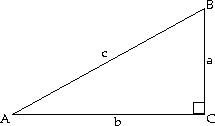A triangle with vertices at (x1, y1), (x2, y2), and (x3, y3) has area equal to the absolute value of D, where  . Use this information to solve the problem.Use D to find the area of the triangle with vertices at P, Q, and R. P(0, -5), Q(0, 0), R(5, -2)
. Use this information to solve the problem.Use D to find the area of the triangle with vertices at P, Q, and R. P(0, -5), Q(0, 0), R(5, -2)
A. 12
B. 
C. 25
D. 0
Answer: B
You might also like to view...
Solve the right triangle. If two sides are given, give angles in degrees and minutes. A = 16° 21', c = 225 ftRound side lengths to two decimal places.
A = 16° 21', c = 225 ftRound side lengths to two decimal places.
A. B = 73° 39'; a = 62.77 ft ; b = 215.01 ft B. B = 74° 38'; a = 63.34 ft; b = 211.90 ft C. B = 73° 39'; a = 63.34 ft; b = 215.90 ft D. B = 73° 38'; a = 66.54 ft; b = 217.10 ft
Solve. Use ? ? 3.14 when necessary.A flagpole 9 feet tall casts a shadow that is 12 feet long. Find the length of the shadow cast by an antenna which is 42 feet tall. Round to the nearest tenth if necessary.
A. 45 feet B. 56 feet C. 31.5 feet D. 2.6 feet
Solve the rational equation. =
= 
A. -12
B. 
C. - 
D. 6
Solve the problem.In a 1-mile race, the winner crosses the finish line 10 feet ahead of the second-place runner and 30 feet ahead of the third-place runner. Assuming that each runner maintains a constant speed throughout the race, by how many feet does the second-place runner beat the third-place runner? (5280 feet in 1 mile.)
A. -20.11 ft B. 10.02 ft C. -10.06 ft D. 20.04 ft